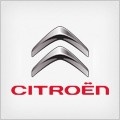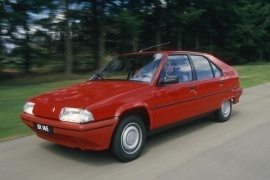
CITROEN BX
Generations Timeline, Specs and Pictures

The Citroen BX was the car that saved the Citroen brand from collapse.
After the 1986 refresh, in 1989 there was a new range of engines installed in the car, to cope with the market requirements.
The Citroen BX was built to replace the aged GSA model. Its design was created by Marcello Gandini from Bertone Studios. It was the same designer that shaped the Lamborghini Countach. The initial design was offered in 1979 to Volvo as a concept car named Tundra, but the Sweedish company thought it was too much for that era. Citroen bought the project and asked Bertone to make it a 4-door hatchback. And the “origami-design” was approved and appreciated by the Peugeot-Citroen board.
In 1989 the BX received a new design for wheel-caps and door handles. It featured the same straight-lines design, with angular greenhouse and sharp front-end. The transverse-engine architecture allowed the engines to be mounted tilted rearward so it could have a narrow front end.
Inside, the instrument cluster was cluttered with more dials, especially for the top versions that featured an electronic fuel-injection system. But it was still easy to read. The side-satellites for the turn-signals were replaced with regular stalks. Even though the car was considered as a medium-sized vehicle, it was cramped even by 1982 standards when the car was shown. In 1989 it was even more difficult.
There were few new engines installed for the 1989 model, but the most important improvement was the introduction of the all-wheel-drive system with the 1.9-liter gasoline engine.

The BX was manufactured as a modern hatchback successor to the aging GS and GSA models.
The angular design was reminiscent of the Volvo Tundra concept, but the coincidence came from the fact that both cars were designed by Marcelo Gandini, who was the head of design at Bertone during the time. Benefiting from the Peugeot-Citroen merger in 1976, the BX shared many components with the Peugeot 405, but it was spiced up with Citroen’s own technology: hydro-pneumatic self-leveling suspension, disc brakes all around and numerous plastic body panels. The 1986 facelift brought few changes, the white signals on the front being the only visual differences.

Citroen started working on the BX model in the ’70s, but its bankruptcy put the project on hold until Peugeot bought the carmaker and financed it.
The car was designed to replace the GS model, which was on the market since 1970. Still, there was a disagreement regarding the exterior design, which calmed down after the carmaker bought the Volvo Tundra project from Bertone Studios. Volvo rejected it because it was considered too bold but fitted Citroen’s needs like a glove. Despite its angular shapes, the hatchback featured a lower drag coefficient than the GS’s, and its size matched the carmaker’s needs. Moreover, its platform was cheaper than the one used for the GS. It featured McPherson struts at the front instead of double-wishbones. Still, it worked well together with the already famous hydropneumatic, self-leveling suspension system.
On the outside, it looked like the designers used only rulers and straight-angles to design the car. Its squared headlights with small, corner-mounted turn signals flanked the front of the hood, which was angled down. Citroen cooled the engine through a grille-mounted in the lower side of the wrapped-around plastic bumper. On the sides, the flush door handles and the flat body panels were completely different than the rounded shapes used by Citroen before. The raked-forward C-pillars and tailgate formed a Kammback styling at the back, while the taillights were also squared.
Inside, the French carmaker installed a squared-looking dashboard with flat panels. The instrument cluster featured most of the buttons mounted on the sides, including the turn-signal rocker-switcher, which had to be turned off by the driver. A one-spoke steering wheel was unusual for other carmakers, but not for Citroen, who used that system since the ’50s. Thanks to the transverse-mounted engine, the car offered enough room for up to five passengers.
Under the hood, Citroen relied on Peugeot’s engines with 1.4-liter and 1.6-liter displacements. Later on, the carmaker added more powerplants to the BX lineup.























































